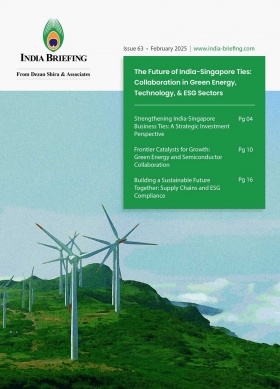India to Mandate Disclosure of Workplace Harassment, Maternity Compliance in Board Reports
India has amended the Companies (Accounts) Rules to mandate that listed companies in the country disclose workplace sexual harassment cases and maternity benefit compliance in their board reports starting July 14, 2025. The rules also update digital filing procedures and standardize statutory forms to streamline compliance and enhance corporate transparency on employee welfare and gender-sensitive issues.
India’s Union Ministry of Corporate Affairs (MCA) has introduced new amendments to the Companies (Accounts) Rules, 2014, through the Companies (Accounts) Second Amendment Rules, 2025.
The latest amendments introduce new disclosure mandates for listed companies, requiring detailed reporting on workplace sexual harassment cases and compliance with maternity benefit laws. Effective July 14, 2025, these changes aim to enhance transparency and strengthen gender-sensitive reporting standards among listed companies in India.
New mandate on harassment and maternity disclosures in board reports
One of the major changes introduced through the Companies (Accounts) Second Amendment Rules, 2025, mandates that listed companies in India must now include detailed disclosures on workplace sexual harassment. The MCA issued the gazette notification on May 30, 2025.
Specifically, companies will be required to report the number of sexual harassment complaints received and resolved during the financial year. This also includes the number of cases that remain pending for more than 90 days.
In addition, the board report must now also include a declaration regarding the company’s compliance with the provisions of the Maternity Benefit Act, 1961.
CLICK HERE: Legal Guide to Maternity Benefits in India for Employers
Previously, companies were only obligated to confirm the establishment of an Internal Complaints Committee as per the Sexual Harassment of Women at Workplace (Prevention, Prohibition, and Redressal) Act, 2013. The amended rules now go further by requiring quantitative and compliance-based disclosures.
Industry welcomes focus on employee welfare
Experts in India have endorsed the move, highlighting its potential to promote ethical workplace practices and reinforce women’s rights in professional environments. According to industry professionals, the enhanced reporting requirements are a progressive step toward achieving substantive equality in the workplace.
Corporate board reports are typically prepared at the end of the financial year. These reports hold comprehensive disclosures that provide stakeholders with insights into a company’s financial and non-financial performance. They usually cover areas such as energy efficiency measures, technological advancements, and foreign exchange transactions. With the latest amendments, the scope of non-financial reporting has now been broadened to include employee welfare metrics as well.
ALSO READ: India’s POSH Act: Annual Reporting Obligations and Proposed Amendments
Digital filing and form revisions to streamline corporate compliance
Alongside the new content requirements, the amendments also bring procedural improvements aimed at enhancing efficiency in corporate filings. One of the key changes is the shift to electronic formats for statutory forms. References to physical forms such as Form AOC-1 and AOC-2 have now been officially replaced with their digital counterparts, e-Form AOC-1 and e-Form AOC-2.
“AOC” stands for Accounts of Company. The compliance forms refer to a set of statutory filing forms prescribed under the Companies Act, 2013, specifically dealing with the filing of financial statements and related reports with the Registrar of Companies (RoC).
Furthermore, companies will now be required to submit extracts of the board report and auditor’s reports—both standalone and consolidated. These supporting documents must be filed in PDF format, ensuring consistency and ease of access for regulators and stakeholders.
The amended rules also introduce updated versions of multiple e-forms, including AOC-1, AOC-2, AOC-4, AOC-4 CFS, AOC-4 NBFC (Ind AS), AOC-4 CFS NBFC (Ind AS), and CSR-2. These revisions aim to standardize reporting formats and make compliance procedures more seamless for companies.
Types of AOC forms and their purpose
- Form AOC-4: This is the main form used by companies to file standalone financial statements, including the Board’s Report, Auditor’s Report, and other documents for each financial year.
- Form AOC-4 CFS: This is used to file consolidated financial statements when a company has subsidiaries, associates, or joint ventures.
- Form AOC-4 NBFC (Ind AS) and AOC-4 CFS NBFC (Ind AS): These are specific to NBFCs (non-banking financial companies) that follow Indian Accounting Standards (Ind AS). These forms align with Ind AS-based disclosures and presentation requirements.
- Form AOC-1: This is filed as an annexure to the financial statements to provide details of a company’s subsidiaries, associates, or joint ventures.
- Form AOC-2: Used to disclose related party transactions that are material and require approval by the board or shareholders, as per Section 188 of the Companies Act.
About Us
India Briefing is one of five regional publications under the Asia Briefing brand. It is supported by Dezan Shira & Associates, a pan-Asia, multi-disciplinary professional services firm that assists foreign investors throughout Asia, including through offices in Delhi, Mumbai, and Bengaluru in India. Dezan Shira & Associates also maintains offices or has alliance partners assisting foreign investors in China, Hong Kong SAR, Vietnam, Indonesia, Singapore, Malaysia, Mongolia, Dubai (UAE), Japan, South Korea, Nepal, The Philippines, Sri Lanka, Thailand, Italy, Germany, Bangladesh, Australia, United States, and United Kingdom and Ireland.
For a complimentary subscription to India Briefing’s content products, please click here. For support with establishing a business in India or for assistance in analyzing and entering markets, please contact the firm at india@dezshira.com or visit our website at www.dezshira.com.
- Previous Article A Guide to India’s Special Economic Zones
- Next Article Five Years of India-Australia Comprehensive Strategic Partnership: Key Milestones








